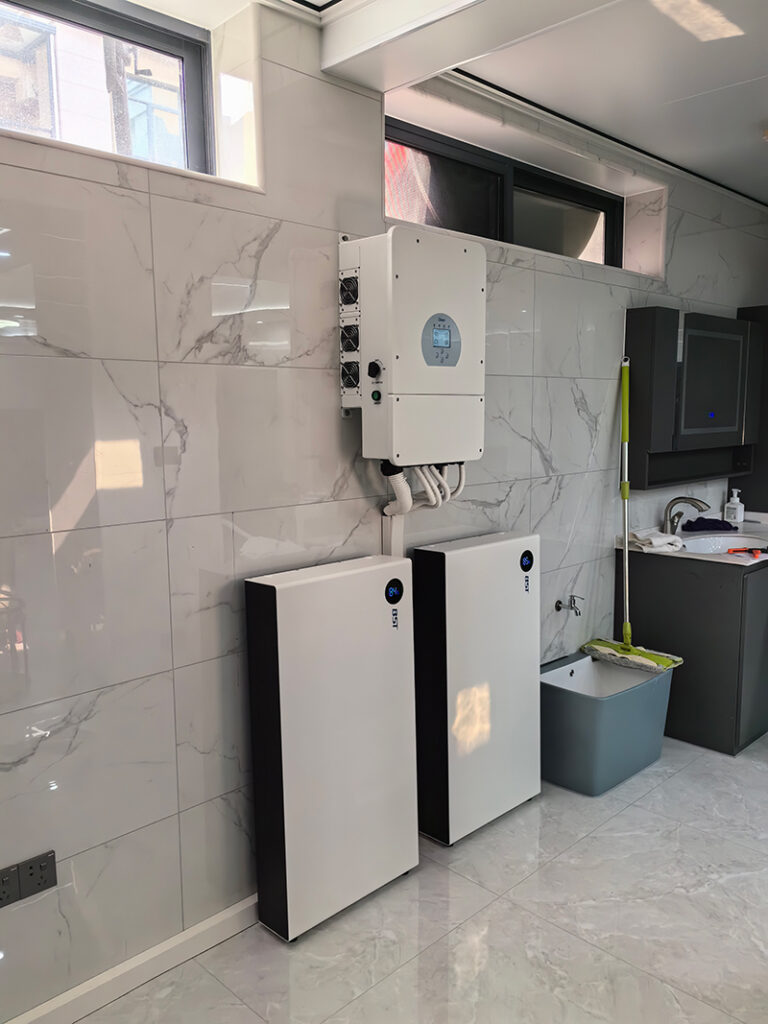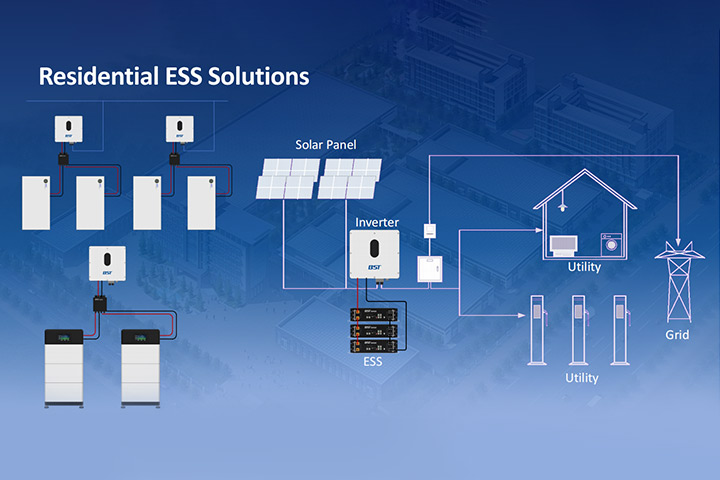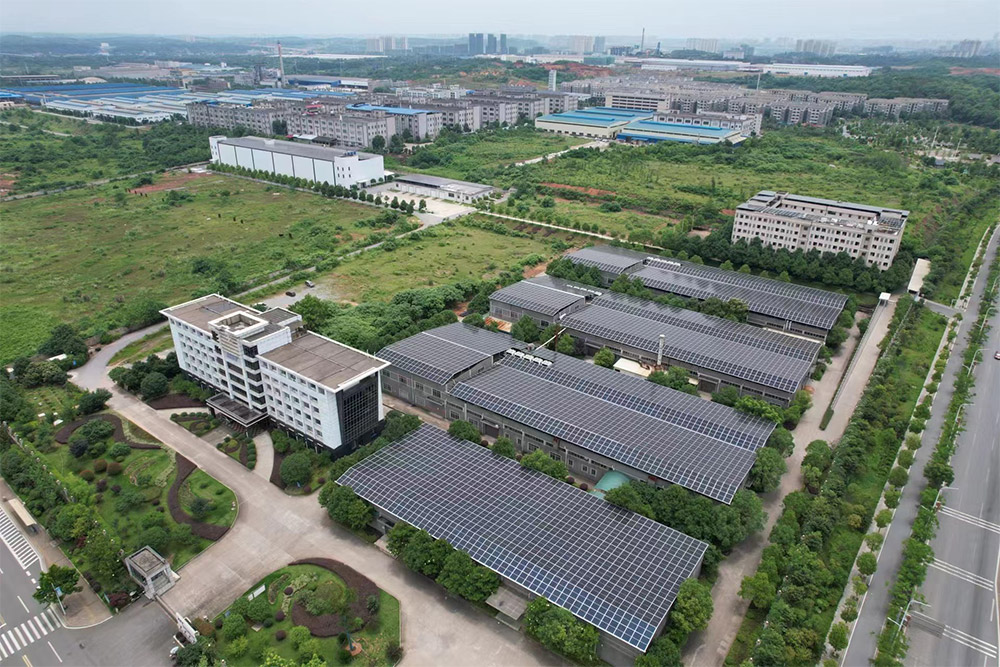As the global energy landscape continues to evolve, the demand for efficient, scalable, and versatile energy storage solutions has become more pronounced. Among the various types of energy storage batteries, wall-mounted, rack-mounted, and stacked configurations have emerged as leading options, each catering to specific needs and market segments. These batteries play a critical role in residential, commercial, and industrial applications, offering a range of benefits that address the growing demand for sustainable energy solutions.

Market Share and Future Trends
In the current market, energy storage solutions are becoming increasingly popular, driven by the need for greater energy independence, grid stability, and the integration of renewable energy sources. According to recent market reports, wall-mounted energy storage batteries hold a significant share of the residential market, particularly in developed regions like North America and Europe, where homeowners are increasingly adopting solar energy systems paired with home battery storage. This trend is expected to continue, with a compound annual growth rate (CAGR) of over 20% in the next five years.

Wall-mounted energy storage batteries are particularly popular in residential markets due to their sleek design and seamless integration into home environments. These batteries are mounted on walls, freeing up valuable floor space, and making them ideal for urban homes where space is at a premium. They typically use lithium iron phosphate (LiFePO4) chemistry, which offers high safety, stability, and a long lifespan. The cobalt-free nature of these batteries also makes them more environmentally friendly. Additionally, wall-mounted batteries are scalable, allowing homeowners to expand their energy storage capacity as needed, up to 102.4kWh. With easy installation, compatibility with various inverters, and remote monitoring capabilities, these batteries provide a reliable and aesthetically pleasing solution for residential energy storage.
Rack-mounted energy storage batteries, on the other hand, dominate the commercial and industrial sectors. Their modular design and high energy density make them ideal for large-scale applications, such as data centers, telecom stations, and commercial buildings. The market for rack-mounted batteries is projected to grow steadily, driven by the increasing need for reliable backup power and the expansion of renewable energy projects worldwide.
Stackable energy storage batteries are gaining traction due to their flexibility and ease of use. These batteries are particularly popular in regions with unreliable grid infrastructure or in off-grid applications. Their ability to be easily transported, installed, and expanded makes them a versatile choice for both residential and commercial users. The market for stackable batteries is expected to see significant growth, especially in emerging markets where energy storage solutions are becoming a necessity.
With these market trends in mind, it’s essential to understand the key features, application areas, and advantages of each type of energy storage battery. This analysis will help potential buyers make informed decisions based on their specific needs and circumstances.
Wall-Mounted Energy Storage Battery

Application Areas:
Wall-mounted energy storage batteries are predominantly used in residential settings, where space is often limited, and aesthetics are important. They are also suitable for small commercial setups that require a discreet and compact energy storage solution. The design of these batteries allows them to be seamlessly integrated into the home environment, providing a balance between functionality and style.
Key Features:
- Cobalt-free Lithium Iron Phosphate Battery: Wall-mounted energy storage batteries typically use lithium iron phosphate (LiFePO4) chemistry, which is known for its high safety, thermal stability, and long lifespan. Unlike traditional lithium-ion batteries that use cobalt, LiFePO4 batteries are cobalt-free, making them more environmentally friendly and less prone to thermal runaway, a condition where the battery can overheat and potentially catch fire.
- Easy Installation: One of the standout features of wall-mounted batteries is their ease of installation. These batteries are designed to be mounted directly on walls, either indoors or outdoors. The ultra-thin design ensures that they do not take up much space, making them ideal for homes with limited floor space. Installation can be done quickly, often within a few hours, by a qualified technician. Additionally, the batteries can be floor-mounted if wall installation is not feasible.
- Scalability: Wall-mounted batteries offer significant scalability, which is a crucial feature for homeowners looking to expand their energy storage capacity over time. These batteries can be scaled up to 102.4kWh by connecting multiple units in parallel, allowing users to increase their storage capacity as their energy needs grow. This feature is particularly useful for households that plan to expand their solar energy systems or expect their energy consumption to increase in the future.
- Compatibility: Wall-mounted energy storage batteries are designed to be compatible with a wide range of inverters, making them a versatile choice for different solar energy systems. This compatibility ensures that the batteries can be easily integrated into existing setups without the need for significant modifications. Additionally, these batteries support the BST cloud, which enables remote monitoring and remote upgrades. This feature allows users to monitor their energy storage systems from anywhere, ensuring optimal performance and timely maintenance.
- Space Saving: The compact and ultra-thin design of wall-mounted batteries makes them a space-saving solution for residential and small commercial environments. Unlike traditional battery systems that require dedicated floor space, wall-mounted batteries can be installed in unused vertical spaces, such as on walls in garages, utility rooms, or even living areas. This design not only saves space but also adds a modern and sleek appearance to the home.
- IP65 Design: Wall-mounted energy storage batteries often come with an IP65 rating, meaning they are dust-tight and protected against water jets. This makes them suitable for both indoor and outdoor installations, as they can withstand harsh environmental conditions, including rain and dust. The robust design ensures long-term durability and reliability, even in challenging environments.
- Aesthetic Appeal: Beyond their functional benefits, wall-mounted batteries are designed with aesthetics in mind. Their sleek and modern appearance allows them to blend seamlessly into residential environments, whether mounted in living rooms, hallways, or garages. The integration of these batteries into the home’s design adds to their appeal, making them a preferred choice for homeowners who value both form and function.
Best Suited For:
Wall-mounted energy storage batteries are best suited for residential homes, particularly those with limited space and a need for aesthetically pleasing energy storage solutions. They are also ideal for small commercial setups where space efficiency and design are important considerations. The high safety, scalability, and remote monitoring capabilities make these batteries a reliable and future-proof choice for homeowners and small business owners alike.
Rack-Mounted Energy Storage Battery

Application Areas:
Rack-mounted energy storage batteries are predominantly used in commercial and industrial settings. Their modular design and high energy density make them ideal for large-scale energy storage applications, such as data centers, telecom stations, commercial buildings, and industrial facilities. These batteries are also used in grid stabilization projects and renewable energy plants, where large amounts of energy need to be stored and managed efficiently.
Key Features:
- Lithium Iron Phosphate Battery: Similar to wall-mounted batteries, rack-mounted energy storage batteries also use lithium iron phosphate (LiFePO4) chemistry, known for its safety, stability, and long cycle life. This makes them reliable for critical applications where safety and longevity are paramount. The use of LiFePO4 batteries in rack-mounted systems ensures that they can handle high power loads and provide consistent performance over time.
- 19-Inch Modular Design: Rack-mounted energy storage batteries are designed to fit into standard 19-inch server racks, making them easy to integrate into existing IT infrastructure. This modular design allows for flexible deployment in various settings, including data centers, telecom stations, and commercial buildings. The standard size ensures compatibility with a wide range of equipment racks, simplifying the installation process and reducing the need for custom enclosures.
- High Energy Density: One of the key advantages of rack-mounted batteries is their high energy density. These batteries can deliver 5kW of power in a 3U (approximately 5.25 inches) ultra-thin body, maximizing the amount of energy stored in a limited space. This high energy density makes rack-mounted batteries an ideal choice for environments where space is at a premium, such as data centers and telecom facilities.
- Scalability: Rack-mounted energy storage systems offer excellent scalability, making them suitable for a wide range of applications. Multiple units can be connected in parallel, with some systems supporting up to 15 units, resulting in a total capacity of up to 76kWh. This scalability allows businesses to start with a smaller system and expand it as their energy needs grow, ensuring that they only invest in what they need when they need it.
- Compatibility: Rack-mounted batteries are designed to be compatible with a wide range of sensors and inverter brands, ensuring seamless integration into existing energy management systems. This compatibility allows businesses to optimize their energy storage systems for specific applications, such as peak shaving, load balancing, or backup power. Additionally, these batteries support BST cloud for remote monitoring and management, enabling businesses to monitor their energy storage systems in real-time and perform remote upgrades as needed.
- Ease of Installation: The modular design of rack-mounted batteries simplifies the installation process, making it easy to deploy and manage large-scale energy storage systems. The batteries can be easily mounted in standard racks, reducing the need for custom installations and minimizing downtime. This ease of installation is particularly beneficial for businesses that need to deploy energy storage systems quickly and efficiently, such as during emergencies or for grid stabilization projects.
Best Suited For:
Rack-mounted energy storage batteries are best suited for commercial and industrial facilities with high energy demands and limited space. They are ideal for data centers, telecom stations, and other critical infrastructures that require reliable, scalable, and high-density energy storage solutions. The flexibility, compatibility, and ease of installation make rack-mounted batteries a preferred choice for large-scale energy storage projects, where performance and reliability are essential.
Stackable Energy Storage Battery

Application Areas:
Stackable energy storage batteries are highly versatile and can be used in residential and commercial settings. Their plug-and-play design and flexible expansion capabilities make them suitable for a wide range of applications, from off-grid installations to backup power for small businesses. These batteries are particularly popular in regions with unreliable grid infrastructure or in situations where energy storage needs may change over time.
Key Features:
- Cobalt-free Li-FePO4 Batteries: Stackable energy storage batteries use cobalt-free lithium iron phosphate (Li-FePO4) batteries, which offer high safety, thermal stability, and a long lifespan. The absence of cobalt makes these batteries more environmentally friendly and reduces the risk of supply chain disruptions. The high safety profile of Li-FePO4 batteries ensures that stackable systems can be used in a variety of environments, including those with stringent safety requirements.
- Plug and Play: One of the most significant advantages of stackable batteries is their plug-and-play design. This feature allows users to quickly and easily install the batteries without the need for specialized tools or expertise. The plug-and-play design also simplifies the process of expanding the system, as additional batteries can be added without the need for complex wiring or configuration. This flexibility makes stackable batteries an ideal choice for users who need to adjust their energy storage capacity on the fly.
- Soft Start: Stackable energy storage batteries often feature a soft start mechanism, which provides a smoother transition when the system is powered on. This reduces the initial surge of power that can cause wear and tear on connected devices, prolonging their lifespan and improving overall system reliability. The soft start feature is particularly beneficial in applications where sensitive electronics are used, such as in residential or small business environments.
- Lightweight and Easy to Transport: Stackable batteries are designed to be lightweight and easy to transport, making them suitable for off-grid installations or situations where mobility is essential. Their compact size and reduced weight allow for easy handling during installation and relocation, reducing labor costs and installation time. This portability is a key advantage for users who need a flexible and mobile energy storage solution.
- Compatibility: Stackable energy storage batteries are compatible with both single-phase and three-phase high-voltage battery inverters, offering flexibility in various applications. This compatibility ensures that the batteries can be used in a wide range of settings, from residential homes to small commercial installations. The ability to work with different inverter types also allows users to optimize their energy storage systems for specific needs, such as backup power, peak shaving, or off-grid use.
Best Suited For:
Stackable energy storage batteries are best suited for users who need a flexible, expandable, and easy-to-install energy storage solution. They are ideal for off-grid installations, backup power for small businesses, and residential applications where energy needs may change over time. The plug-and-play design, lightweight construction, and compatibility with various inverters make stackable batteries a versatile choice for a wide range of users.
Detailed Summary
When comparing wall-mounted, rack-mounted, and stacked energy storage batteries, several factors must be considered, including installation cost, ease of installation, and application areas. Each type of battery offers unique advantages, making them suitable for different scenarios.

Installation Cost
- Wall-Mounted Batteries: Wall-mounted energy storage batteries generally have a moderate installation cost. While the installation process is straightforward, it may require additional structural support, particularly if the battery is heavy or if it is being installed on an exterior wall. However, the space-saving design and ease of integration into the home environment can offset these costs.
- Rack-Mounted Batteries: Rack-mounted energy storage batteries are often more expensive to install, especially in commercial and industrial settings. The need for specialized racks and the complexity of connecting multiple units in parallel can drive up installation costs. However, the high energy density and scalability of these batteries make them a cost-effective solution for large-scale applications, where the upfront investment can be justified by the long-term savings in energy management and backup power.
- Stackable Batteries: Stackable energy storage batteries have the lowest installation costs among the three types. The plug-and-play design eliminates the need for specialized installation tools or expertise, reducing labor costs and installation time. Additionally, the lightweight and portable nature of these batteries further reduces transportation and handling costs, making them an economical choice for users with limited budgets.
Ease of Installation
- Wall-Mounted Batteries: Wall-mounted batteries are relatively easy to install, especially in residential settings. The installation process is straightforward, and the ultra-thin design allows for quick mounting on walls or floors. However, care must be taken to ensure that the mounting surface can support the weight of the battery, and professional installation may be required to ensure safety and proper operation.
- Rack-Mounted Batteries: Rack-mounted batteries are easy to install in commercial and industrial settings, particularly if they are being integrated into existing IT infrastructure. The modular design allows for easy expansion and maintenance, but the installation process may be more complex than that of wall-mounted or stackable batteries. Specialized racks and equipment may be required, and professional installation is recommended to ensure proper setup and operation.
- Stackable Batteries: Stackable batteries are the easiest to install among the three types. The plug-and-play design allows for quick and hassle-free installation, with no need for specialized tools or expertise. The lightweight and portable nature of these batteries further simplifies the installation process, making them an ideal choice for users who need a flexible and easy-to-deploy energy storage solution.
Application Areas
- Wall-Mounted Batteries: Wall-mounted energy storage batteries are best suited for residential and small commercial settings, where space efficiency and aesthetics are important. Their compact and sleek design allows them to be seamlessly integrated into the home environment, making them an ideal choice for homeowners looking for a discreet and functional energy storage solution.
- Rack-Mounted Batteries: Rack-mounted energy storage batteries are ideal for commercial and industrial applications, where large-scale energy storage and high energy density are required. They are commonly used in data centers, telecom stations, and other critical infrastructure, where reliability, scalability, and performance are paramount.
- Stackable Batteries: Stackable energy storage batteries are highly versatile and can be used in a wide range of applications, from off-grid installations to backup power for small businesses and residential homes. Their plug-and-play design and flexible expansion capabilities make them an ideal choice for users who need a portable and adaptable energy storage solution.
Conclusion:
In conclusion, each type of energy storage battery offers distinct advantages, making them suitable for different scenarios. Wall-mounted batteries provide a space-saving and aesthetically pleasing solution for residential and small commercial settings. Rack-mounted batteries offer high scalability, energy density, and reliability for commercial and industrial applications. Stackable batteries provide unmatched flexibility, ease of installation, and portability, making them ideal for a wide range of users, from off-grid enthusiasts to small business owners.

By understanding the unique features and benefits of each type of energy storage battery, potential buyers can make informed decisions based on their specific needs and circumstances. Whether you are looking for a discreet home energy storage solution, a robust commercial energy storage system, or a flexible and portable energy storage option, there is a battery type that meets your requirements.



